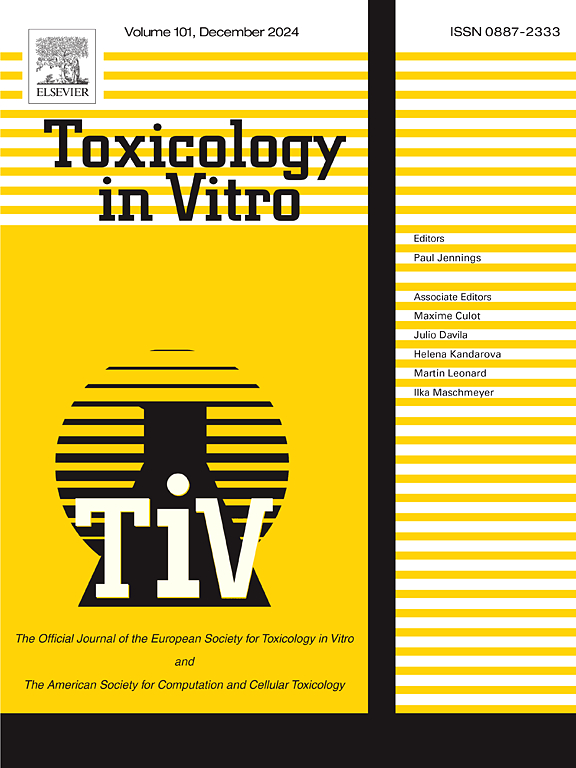体外Caco-2细胞对富含cbd的乙醇大麻提取物中5种大麻素的肠道吸收的评估。
IF 2.6
3区 医学
Q3 TOXICOLOGY
引用次数: 0
摘要
大麻素是大麻植物的高度亲脂性成分,存在于用于消费的几种产品中。虽然大麻二酚(CBD)对人类的影响已经被广泛研究,但关于其他少量大麻素的信息有限。CBD口服生物利用度低,但随着食物和高脂肪摄入而增加。我们在体外使用Caco-2细胞来评估富含CBD的大麻提取物中存在的五种大麻素(CBD, CBC, CBG, CBN和CBDV)的肠道吸收。我们使用进食状态模拟肠液(Fessif)来溶出大麻素。大麻素不改变Caco-2单层完整性。除CBC外,与60分钟孵育相比,90分钟孵育后大麻素的回收率显着下降。在底部的房间里没有发现可测量的大麻素。大麻提取物或含有30 μM CBD的大麻素混合物孵育后,CBD、CBC、CBG和CBN的回收率没有变化,但CBDV的回收率下降。大麻提取物或含有10 μM CBD的混合物,CBD和CBC的回收率没有变化,CBG的回收率较低(80-82 %),CBN和CBDV无法量化。本研究强调了评估Caco-2细胞对大麻素的渗透性以预测肠道吸收的挑战,包括这些化合物的物理化学性质,培养时间和细胞性质。本文章由计算机程序翻译,如有差异,请以英文原文为准。
Assessment of intestinal absorption of five cannabinoids from an ethanolic CBD-rich hemp extract using Caco-2 cells in vitro
Cannabinoids are highly lipophilic constituents of the hemp plant, which is present in several products intended for consumption. While cannabidiol (CBD) effects to humans have been extensively investigated, there is limited information on other minor cannabinoids. CBD oral bioavailability is low but increases with food and high-fat intake. We used Caco-2 cells in vitro to assess intestinal absorption of five cannabinoids (CBD, CBC, CBG, CBN, and CBDV) present in a CBD-rich hemp extract. We used a fed-state simulated intestinal fluid (Fessif) for dissolution of cannabinoids. Cannabinoids did not alter Caco-2 monolayer integrity. Except for CBC, recovery of cannabinoids decreased significantly after 90-minute incubation, compared to 60-minute incubation. No measurable cannabinoids were identified in the bottom chambers. Recovery of CBD, CBC, CBG and CBN after incubation with hemp extract or cannabinoid mix containing 30 μM CBD was unchanged, but CBDV recovery decreased. With hemp extract or a mix containing 10 μM CBD, recovery of CBD and CBC did not change, CBG recovery was lower (80–82 %), and CBN and CBDV were unquantifiable. This study highlights the challenges of evaluating permeability of cannabinoids by Caco-2 cells to predict intestinal absorption, including the physicochemical properties of these compounds, incubation time and cell properties.
求助全文
通过发布文献求助,成功后即可免费获取论文全文。
去求助
来源期刊

Toxicology in Vitro
医学-毒理学
CiteScore
6.50
自引率
3.10%
发文量
181
审稿时长
65 days
期刊介绍:
Toxicology in Vitro publishes original research papers and reviews on the application and use of in vitro systems for assessing or predicting the toxic effects of chemicals and elucidating their mechanisms of action. These in vitro techniques include utilizing cell or tissue cultures, isolated cells, tissue slices, subcellular fractions, transgenic cell cultures, and cells from transgenic organisms, as well as in silico modelling. The Journal will focus on investigations that involve the development and validation of new in vitro methods, e.g. for prediction of toxic effects based on traditional and in silico modelling; on the use of methods in high-throughput toxicology and pharmacology; elucidation of mechanisms of toxic action; the application of genomics, transcriptomics and proteomics in toxicology, as well as on comparative studies that characterise the relationship between in vitro and in vivo findings. The Journal strongly encourages the submission of manuscripts that focus on the development of in vitro methods, their practical applications and regulatory use (e.g. in the areas of food components cosmetics, pharmaceuticals, pesticides, and industrial chemicals). Toxicology in Vitro discourages papers that record reporting on toxicological effects from materials, such as plant extracts or herbal medicines, that have not been chemically characterized.
 求助内容:
求助内容: 应助结果提醒方式:
应助结果提醒方式:


